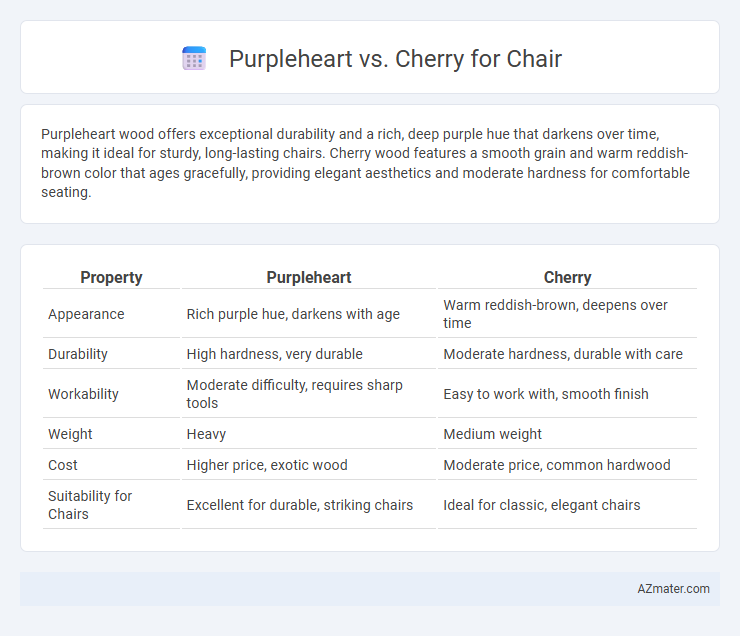Purpleheart wood offers exceptional durability and a rich, deep purple hue that darkens over time, making it ideal for sturdy, long-lasting chairs. Cherry wood features a smooth grain and warm reddish-brown color that ages gracefully, providing elegant aesthetics and moderate hardness for comfortable seating.
Table of Comparison
| Property | Purpleheart | Cherry |
|---|---|---|
| Appearance | Rich purple hue, darkens with age | Warm reddish-brown, deepens over time |
| Durability | High hardness, very durable | Moderate hardness, durable with care |
| Workability | Moderate difficulty, requires sharp tools | Easy to work with, smooth finish |
| Weight | Heavy | Medium weight |
| Cost | Higher price, exotic wood | Moderate price, common hardwood |
| Suitability for Chairs | Excellent for durable, striking chairs | Ideal for classic, elegant chairs |
Introduction to Purpleheart and Cherry Woods
Purpleheart wood, known for its vibrant purple hue and exceptional durability, is sourced primarily from the Peltogyne genus in Central and South America, making it a unique choice for chair construction. Cherry wood, derived from the Prunus serotina species native to North America, features a smooth texture and warm reddish-brown tone that deepens with age, favored for its elegance and workability. Both woods offer distinct aesthetic and physical properties, influencing factors like strength, grain pattern, and long-term maintenance in chair designs.
Physical Appearance: Color and Grain Differences
Purpleheart wood features a striking deep purple hue that darkens with age, offering a unique and bold aesthetic for chairs. Cherry wood presents a warm reddish-brown color that deepens to a rich mahogany over time, appealing to those seeking classic elegance. Grain patterns in Purpleheart are generally straight and fine, while Cherry wood exhibits a smooth, satiny texture with subtle, flowing grain variations.
Durability and Hardness Comparison
Purpleheart wood exhibits exceptional durability with a Janka hardness rating of approximately 2,520 lbf, making it significantly harder and more resistant to wear compared to Cherry wood, which has a Janka hardness of around 950 lbf. This substantial difference in hardness translates to superior scratch and dent resistance in Purpleheart, ideal for furniture like chairs that endure regular use. While Cherry offers a softer, more pliable texture for carving, Purpleheart's toughness ensures longer-lasting structural integrity in high-traffic seating applications.
Workability: Ease of Shaping and Finishing
Purpleheart is harder and denser than Cherry, making it more challenging to shape but providing a durable, smooth finish once properly worked. Cherry wood is comparatively softer, allowing for easier cutting, sanding, and intricate detailing, which results in a warm, uniform surface ideal for chair making. Both woods finish well with hand or machine sanding, but Cherry's superior workability tends to reduce time and effort during the shaping process.
Weight and Density Considerations
Purpleheart wood has a density of approximately 810 kg/m3, making it heavier and denser than Cherry, which typically has a density around 580 kg/m3. This higher density provides Purpleheart chairs with enhanced durability and resistance to wear but also increases the overall weight, potentially impacting mobility and ease of handling. Cherry wood, being lighter, offers a balance of strength and ease of movement, making it suitable for chairs where weight considerations are important.
Cost and Availability in the Market
Purpleheart is generally more expensive than cherry due to its rarity and limited availability, often sourced from tropical rainforests in Central and South America. Cherry wood is widely available and more affordable, being a common hardwood in North America with sustainable harvesting practices. Cost-conscious buyers typically prefer cherry for chair making, while purpleheart appeals to those valuing exotic aesthetics despite the higher investment.
Sustainability and Environmental Impact
Purpleheart wood is sustainably harvested from fast-growing tropical trees, making it a more eco-friendly choice compared to cherry, which is sourced from slower-growing hardwoods often subjected to overharvesting. The dense, durable nature of purpleheart contributes to longer-lasting furniture, reducing the need for replacement and minimizing resource consumption over time. Cherry wood, while biodegradable, involves greater environmental impact due to longer growth cycles and increased deforestation pressures, making purpleheart a preferable option for environmentally conscious chair manufacturing.
Comfort and Practicality for Chair Use
Purpleheart offers exceptional durability and resistance to wear, making it a practical choice for chair use, while its dense grain provides firm support but may feel less comfortable over long periods. Cherry wood features a smoother texture and slight natural flexibility, enhancing comfort without sacrificing stability, making it ideal for extended seating. Both woods age beautifully, with Purpleheart developing a rich purple hue and Cherry deepening to a warm reddish-brown, offering practical aesthetics alongside comfort.
Maintenance and Longevity of Chairs
Purpleheart wood offers superior durability and resistance to wear, making it an excellent choice for chair longevity, as it naturally resists decay and insect damage. Cherry wood requires more regular maintenance, such as periodic refinishing and protection from moisture, to prevent surface wear and maintain its rich color. Chairs made from Purpleheart typically endure longer with less upkeep, while Cherry chairs benefit from attentive care to preserve their aesthetic and structural integrity over time.
Best Choice for Chair-Making: Purpleheart or Cherry?
Purpleheart and Cherry both offer distinct advantages for chair-making, with Purpleheart prized for its exceptional durability and rich purple hue that darkens over time, providing a unique aesthetic appeal. Cherry wood is favored for its fine grain, smooth texture, and warm reddish-brown color that deepens with age, making it a popular choice for traditional and elegant chair designs. For long-lasting strength combined with distinctive color, Purpleheart is ideal, while Cherry excels in classic beauty and ease of finishing, making the best choice dependent on desired style and durability requirements.

Infographic: Purpleheart vs Cherry for Chair
 azmater.com
azmater.com